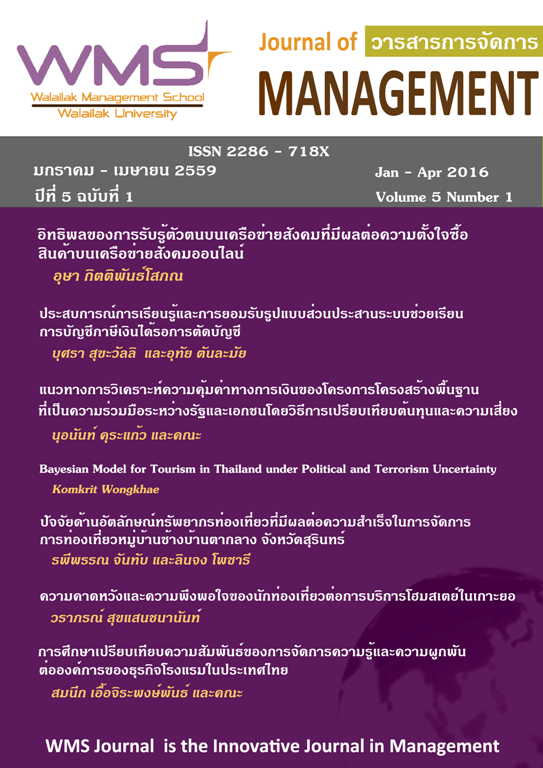Learning Experience and Acceptance of Interface Features of the Computer Assisted Learning on Deferred Tax Accounting
Main Article Content
Abstract
This research aims at developing a Computer-Assisted Instruction (CAI) application for deferred tax accounting topic and use it to study the acceptance of this CAI and its user’s learning experience. The CAI was developed so as to align user interface features in terms of question format and technology. A semi-experimental research was conducted with 4 groups by crossing two interface features, specifically 2 types of question format and two types of interface technology in order to have a 2 x 2 group design: Group1-Picture question with Touch screen interface, Group2-Picture question with Mouse-click interface, Group3-Text-based question with Touch screen interface, and Group4-Text-based question with Mouse-click interface. Experimental unit samples are 120 second-year and third-year undergraduate accounting students who had a basic knowledge of accounting and taxation but have not taken deferred tax accounting subject.
The analysis of the relationship between Learning Experience, including Learning Score and Use Experience, and the Acceptance of CAI found that Acceptance of CAI, in terms of Perceived Ease of Use and Perceived Usefulness, was partially related to Learning Experience. The positive relationship was statistical significant only between Acceptance of CAI and Use Experience but not between Acceptance of CAI and Learning Score. However, the experimental results showed that the Post-test scores were significantly higher than the Pre-test scores for Group1-Picture question and Computer with touch screen, Group2-Picture question and Computer with mouse-click, and Group4-Text-based question and Computer with mouse-click. No statistically significant difference was found in Group3-Text-based question and Computer with touch screen.Article Details
References
กิ่งกนก รัตนมณี. (2552). การเข้าปัจจัยเสี่ยงตามแบบแสดงรายการข้อมูลประจำปี (แบบ 56-1) โดยนำเสนอข้อมูลด้วยรูปแบบจินตทัศน์. วิทยานิพนธ์ปริญญามหาบัณฑิต สาขาวิชาเทคโนโลยีสารสนเทศทางธุรกิจ คณะพาณิชศาสตร์และการบัญชี, จุฬาลงกรณ์มหาวิทยาลัย.
เกศสุดา รัชฎาวิศิษฐกุล. (2547). การพัฒนาการเรียนการสอนที่สนองต่อรูปแบบการเรียนภาษาอังกฤษของนักศึกษาระดับปริญญาตรี มหาวิทยาลัยธุรกิจบัณฑิต. วิทยานิพนธ์ศึกษาศาสตร์ดุษฎีบัณฑิต สาขาหลักสูตรและการสอน, มหาวิทยาลัยเกษตรศาสตร์.
วรศักดิ์ ทุมมานนน์. (2550). ผลกระทบของการนำนโยบายการบัญชีภาษีเงินได้รอตัดบัญชีมาถือปฏิบัติของบริษัทจดทะเบียนในตลาดหลักทรัพย์แห่งประเทศไทยในช่วงปี 2538-2549. วารสารวิชาชีพบัญชี, 3(7), 27-47.
วรศักดิ์ ทุมมานนน์. (2552). การบัญชีเกี่ยวกับภาษีเงินได้รอการตัดบัญชี. พิมพ์ครั้งที่ 3. กรุงเทพฯ: สำนักพิมพ์ธรรมนิติ.
วิศรุต ศรีบุญนาค. (2554). ภาษีเงินได้รอการตัดบัญชีกับการวางแผนภาษี: บล็อกของภาควิชาบัญชี. สืบค้นเมื่อ 9 สิงหาคม 2555 สืบค้นจาก http://account.acc.
chula.ac.th/index.php?Name=Faculty&action=blog-view&blog content id=47.
บุศรา สุขะวัลลิ. (2557). ความพอดีระหว่างเทคโนโลยีส่วนประสานกับรูปแบบคำถามและประสบการณ์การเรียนรู้จากการใช้คอมพิวเตอร์ช่วยเรียนการบัญชีภาษีเงินได้รอการตัดบัญชี. วิทยานิพนธ์ปริญญามหาบัณฑิต สาขาวิชาเทคโนโลยีสารสนเทศทางธุรกิจ, คณะพาณิชศาสตร์และการบัญชี จุฬาลงกรณ์มหาวิทยาลัย.
สภาวิชาชีพบัญชี ในพระบรมราชูปถัมภ์. (2553). มาตรฐานการบัญชีฉบับที่ 12 เรื่อง ภาษีเงินได้. กรุงเทพฯ: บริษัท พี. เอ. ลีฟวิ่ง จำกัด.
สุธี คทวณิช และกษิติ เกตุสุริยงค์. (2554). ภาษีเงินได้รอการตัดบัญชี. วารสารนักบริหาร, 31(2), 111-121.
Agarwal, R., and Prasad, J. (1999). Are individual differences germane to the acceptance of new information technology?. Decision Sciences, 30(2), 361-391.
Brath, R. and Peters, M. (2005). Information Visualization for Business- Past & Future. DM Review Magazine, (2005, January).
Davis, F. D. (1989). Perceive Usefulness, Perceive Ease of Use and User Acceptance of Information Technology. MIS Quarterly, (1989, September), 319-333.
Huxley, A. (1963). The Doors of Perception. New York: Harper & Row Publishers.
Kemp, J. E. and Smellie, D.C. (1989). Planning, producing and using instructional media: New York: Harper and Row Publishers.
Khattapan, C. N. and Zaidel, M. (2010). Interfaces and Templates in Computer-Assisted Learning: Students’ Assessments and Preferences. International Journal of Arts and Sciences, 3(14), 1-11.
Mark, R. Y. and Eve, M. C. (2008). Evaluating Experiential Learning Activities. Journal for Advancement of Marketing Education, 13(3), 17-41.
Nokelainen, P. and Ruohotie, P. (2004). Empirical Validation of Abilities for Computer Assisted Learning Questionnaire. Finland: Research Centre for Vocational Education, University of Tampere.
Peslak, A. (2005). A Framework and Implementation of User Interface and Human-Computer Interaction Instruction. Journal of Information Technology Education, 4, 189-205.
Roscoe, J. T. (1975). Fundamental Research Statistics for the Behavioural Sciences (2 ed.). New York: Holt Rinehart & Winston.
Russom, P. (2000). Trends in Data Visualization Software for Business Users. DM Review Magazine, (May).
Guttormsen Schär, S., Schluep, S., Schierz, C., & Krueger, H. (2000). Interaction for Computer-Aided Learning. Interactive Multimedia Electronic Journal of Computer-Enhanced Learning, 2(1), 22 pages.
Sharlanova, V. (2004). Experiential Learning. Trakia Journal of Sciences. 2(4), 36-39.
Tanlamai, U. and Tangsiri, K. (2010). Business Information Visuals and User Learning: A Case of Companies Listed on the Stock Exchange of Thailand. Journal of Information Technology Applications & Management, 17(1, March), 11-33.
Tanlamai, U. and Tangsiri, K. (2012). Learning from Schematic Visuals of Financial Ratios. International Journal of Business and Information, 7(2, December), 250-276.
Vessey, I. (1991). Cognitive Fit: A Theory-Based Analysis of the Graphs versus Tables Literature. Decision Sciences, 22(2), 219-240.


